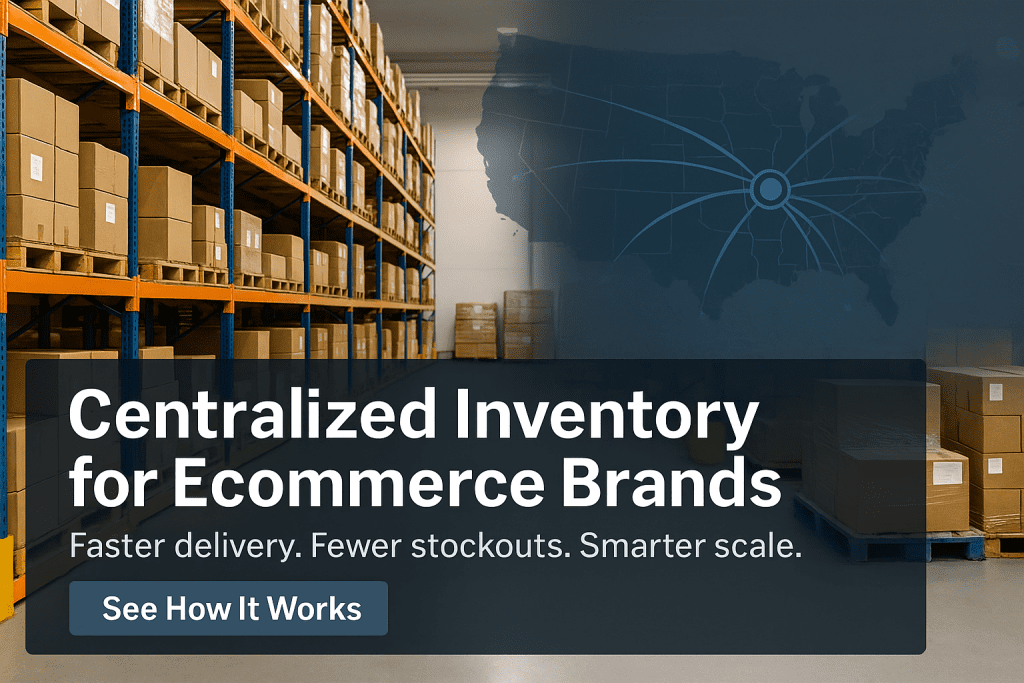Author: Jason Martin
Reviewed by: Supply Chain Solutions Lead
Last updated: September 27, 2025
Executive TLDR
One network view of inventory cuts stockouts and overstock at the same time.
Centralized placement in the Midwest can hit most U.S. customers in 1 to 3 days by ground.
Use clear reorder points, FEFO for dated goods, and tight ASN receiving to keep counts honest.
Start with one primary node, then add forward stocking only when data proves it.
Dashboards with on-hand, on-order, and days of cover drive better buys and fewer emergencies.
Want a clean, centralized setup that ships fast?Contact Product Fulfillment Solutions
Table of contents
What centralized inventory actually means
When centralization beats multi-node
How to stand up a centralized model in 30 days
Controls for dated and regulated products
Cost levers you can pull immediately
Why Product Fulfillment Solutions
FAQ
What centralized inventory actually means
Centralized inventory means you keep most sellable stock in one primary node with a single source of truth for counts, orders, and inbound. Teams plan buys, book receiving, and ship orders from the same hub. With a strong Midwest location and smart pack out rules, you can reach the bulk of U.S. buyers in 1 to 3 business days by ground, while avoiding the complexity tax of too many nodes.
When centralization beats multi-node
Order profile: If most orders are lightweight, ship in a poly or small carton, and do not need overnight by default, a central node is efficient.
Demand pattern: If sales are not wildly regional or peak is predictable, consolidation reduces safety stock duplication.
Catalog shape: If you have many SKUs with a few top movers, centralize the tail and consider forward stocking only the highest velocity SKUs once data proves the need.
Ops maturity: If ASN accuracy, labeling, and location mapping are not perfect yet, centralizing reduces error until the process is tight.
If you grow into retail or wholesale, layer B2B and retail fulfillment standards on the same hub.
How to stand up a centralized model in 30 days
Week 1, get the data right
Build one product master: SKU, barcode, dimensions, weight, case and pallet, hazmat, shelf life, lot expiry rules.
Map each SKU to one scannable barcode and set location formats for receiving.
Choose clear reorder points and target days of cover by SKU class.
Week 2, prepare the floor
Slot top movers near pack, separate look-alikes, and label aisles, bays, and bins with large, high-contrast IDs.
Post a receiving checklist and align ASN fields to carton and pallet labels.
Set a 1 to 3 day dock-to-stock target and track it daily.
Week 3, connect systems and visibility
Turn on dashboards for on-hand, on-order, days of cover, low-stock alerts, and late inbound.
Wire order sources to the WMS and confirm status flows. See real-time information.
Week 4, pilot and tune
Run a pilot across the top 20 percent of SKUs that drive most orders.
Measure pick rate, order accuracy, travel time, and label relabels.
Fix slotting and pack out rules, then scale to the rest of the catalog.
Need a turnkey path, start with 3PL fulfillment and ecommerce fulfillment, then add cross docking solutions as volume grows.
Controls for dated and regulated products
Capture lot, batch, and expiry at receiving, then enforce FEFO at pick.
Use location cards or WMS flags that mark “lot required” bins.
For sets or bundles, print kitting sheets that include lot fields, then audit a small sample daily.
Quarantine suspect product fast, do not mix lots on the same shelf unless rules allow it.
If storage is tight, expand cleanly with warehousing and storage solutions.
Cost levers you can pull immediately
Right-sized packaging: A simple box or mailer matrix cuts DIM charges on small parcels. See discounted shipping rates for carrier options.
Replenishment rhythm: Refill fast movers during low-traffic hours to reduce aisle conflict and overtime.
Exception lanes: Create a small zone for damaged, relabel, and short, so the main flow never stalls.
Forward stocking by proof, not guess: Only add a second node when transit savings beat the extra safety stock and ops complexity.
Why Product Fulfillment Solutions
Central U.S. hub in Cincinnati enabling 1 to 3 day ground to most customers.
Barcode-first receiving aligned to your ASN, driving consistent dock-to-stock speed.
FEFO and lot or expiry control tailored for supplements, vitamins, and other consumables.
Pick and pack standards and kitting for promos, sets, and subscription boxes.
Small-parcel optimization to protect margin, plus retail and EDI readiness when you scale to wholesale.
Explore 3PL fulfillment and international distribution as growth opens new markets.
FAQ
Is centralized inventory slower than multi-node
Not if your hub is central and your pack out is tight. Most U.S. customers can still get 1 to 3 day ground coverage.
How do I choose SKUs for a second node
Pick only top movers with clear regional demand and enough volume to offset extra safety stock and complexity.
What KPIs prove centralization is working
Watch dock-to-stock time, order accuracy, pick lines per hour, days of cover, and cost per order. Travel time per order should trend down.
How do I avoid stockouts while centralizing
Set reorder points, monitor days of cover, and use a weekly review of top movers. Adjust buys early.
Does centralization work with retail or EDI
Yes, if you set ASN and labeling standards. Add EDI solutions and connections as wholesale grows.

